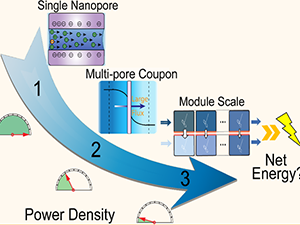Nanopore-Based Power Generation from Salinity Gradient: Why It Is Not Viable
 ACS Nano 2021, 15, 3, 4093–4107
ACS Nano 2021, 15, 3, 4093–4107
Li Wang, Zhangxin Wang, Sohum K. Patel, Shihong Lin, and Menachem Elimelech
The abstract reads as follows: In recent years, the development of nanopore-based membranes has revitalized the prospect of harvesting salinity gradient (blue) energy. In this study, we systematically analyze the energetic performance of nanopore-based power generation (NPG) at various process scales, beginning with a single nanopore, followed by a multipore membrane coupon, and ending with a full-scale system. We confirm the high power densities attainable by a single nanopore and demonstrate that, at the coupon scale and above, concentration polarization severely hinders the power density of NPG, revealing the common, yet significant, error in linearly extrapolating single-pore performance to multipore membranes. Through our consideration of concentration polarization, we also importantly show that the development of materials with exceptional nanopore properties provides limited enhancement of practical process performance. For a full-scale NPG membrane module, we find an inherent tradeoff between power density and thermodynamic energy efficiency, whereby achieving a high power density sacrifices the energy efficiency. Furthermore, we derive a simple expression for the theoretical maximum energy efficiency of NPG, showing it is solely related to the membrane selectivity (i.e., S2/2). Through this relation, it is apparent that the energy efficiency of NPG is limited to only 50% (for a completely selective membrane, i.e., S = 1), reinforcing our optimistic full-scale simulations which result in a (practical) maximum energy efficiency of 42%. Finally, we assess the net extractable energy of a full-scale NPG system which mixes river water and seawater by including the energy losses from pretreatment and pumping, revealing that the NPG process—both in its current state of development and in the case of highly optimistic performance with minimized external energy losses—is not viable for power generation.
This work was supported by CENT, an Energy Frontier Research Center funded by the U.S. Department of Energy, Office of Science, Basic Energy Sciences, under Award No. DESC0019112.
https://pubs.acs.org/doi/10.1021/acsnano.0c08628
